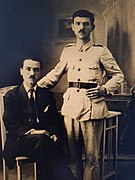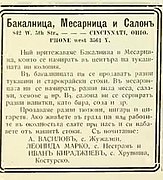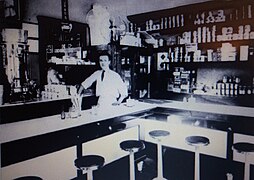
Tom Kiradjieff and John Kiradjieff were Bulgarian American restaurateurs and Macedonian immigrants, credited for their creation of a regional specialty dish known as the Cincinnati chili. [1] [2] [3]
History
The brothers were born in the town of Hrupishta, [4] in the Ottoman Empire, [note 2] [5] to Bulgarian parents. [6] [note 3] [7] [8] The town was annexed during the Balkan Wars (1912-1913) by Greece. The partition of the Ottoman lands of the region of Macedonia between the Balkan nation-states resulted in the fact, that some of the Slavic speakers of Ottoman Macedonia emigrated to Bulgaria, or left the area. [9]
Athanas (Tom) was born in 1892. During the First World War, he was a soldier in the Bulgarian Army. In 1917 he was dismissed and moved to the Bulgarian capital Sofia, where he worked for a time as an accountant. [6] His little brother Ivan (John) born in 1895 had served also some time with the Bulgarian army. [4] In 1921 both emigrated to the United States.
They settled initially in New York, [10] but after selling hot dogs there for some time, the brothers followed their big brother Argir (Argie) to Cincinnati. Born in 1880, he was a cashier of the Bulgarian Exarchate Church-School Board in Hrupishta. [7] Argie had settled in Cincinnati by 1918, where he opened a grocery store. [11] In Cincinnati the brothers began to develop their own business. Tom got a job as a bank clerk and worked at night, cooking chili for the customers in his brother's place. It was at this time that Tom invented the regional specialty known as Cincinnati chili.
In 1922 they opened a hot dog stand located next to a burlesque theater called the Empress, which they named their business after. Tom and John returned to Bulgaria to find wives, while Argir went to his homeland for this purpose. Argir stayed there for several years, and when he came back, his two brothers were well established and provided him a job as a cashier. According to the journalist Vasil Stefanov, [note 4] in 1933 the Kiradjieff brothers were among the most successful Bulgarians in the city, owners of a large and modern restaurant in the city center. [12] [13]
Argir's wife did not adapt to America, and they moved back to Macedonia in the 1940s. [note 5] [4] [14] The Empress Chili grew to become a local chain. In 1959, the Kiradjieffs of Empress Chili, announced they be the first to come up with a new design for drive in, car-service. The last man who ran the family business was Tom's son Assen (Joe) Kiradjieff. Since the late 1950s, when his father's health sharply declined, Joe operated the Empress Chili. Tom died in 1960, while John had died in 1953. Later the Empress chain had a single surviving outlet. In 2009, 79-year-old Joe retired and sold the Empress Chili. [15]
Gallery
-
Ivan Kiradjieff and his little brother Ilia in Bulgarian military uniform.
-
Bulgarian soldiers during WWI. Ivan Kiradjieff is third from left.
-
Advertising from Cincinnati, published in Bulgarian. One of the signed partners is Ivan Kiradjieff.
-
Ivan Kiradjieff and his Bulgarian wife Mila Gandeva in Paris.
-
Ivan Kiradjieff posing in Empress Chili in Cincinnati.
-
Advertisement with Argir Kiradjieff published in Bulgarian newspaper Naroden Glas. [note 6]
See also
Notes
- ^ This photo of the Kiradjieff brothers dated May 29, 1921, was taken at Maly's Studio on 635 Vine Street.
- ^ According to the statistics of Vasil Kanchov ("Macedonia. Ethnography and Statistics") in 1900 the Ottoman Hrupishta had 2690 inhabitants, of which there were 1100 Bulgarians, 700 Turks, 720 Aromanians and 170 Gypsies.
- ^ According to IMARO revolutionaries Georgi Hristov (1876-1964) and Kiryak Shkurtov, the father of the Kiradjhieff brothers Kostadin, was among the leading members of the Bulgarian community in the town.
- ^ Vasil Stefanov (1879 – 1950) was a Bulgarian publicist from Bitola, today in North Macedonia, publisher of the newspaper Naroden Glas (1907 – 1950) in the USA.
- ^ It is not clear when exactly they moved back and which country was their destination. In 1940, this region's northern parts belonged to the Kingdom of Yugoslavia, while the southern parts belonged to the Kingdom of Greece. Between 1941 and 1944 the Yugoslav area and some parts of Greek Macedonia were annexed by the Kingdom of Bulgaria. In 1945 the northern part became a new Yugoslav Republic, while in the southern part broke out the Greek Civil War. The northeastern part remained under Bulgaria during the whole period.
- ^ Naroden Glas was a Bulgarian newspaper, an agency of the Macedonian Bulgarian emigrants to the United States. It was published in Bulgarian in the period from 1907 to 1950 in Granite City.
Footnotes
- ^ Cincinnati chilly an article by Lucy M. Long in Deutsch, Jonathan, Benjamin Fulton, and Alexandra Zeitz. (2018). We eat what?: a cultural encyclopedia of unusual foods in the United States. pp. 91-94. ISBN 1440841128.
- ^ Claude Fischler, Chapter 40 (The “McDonaldization” of culture') in J.L. Flandrin and M. Montanari, eds., Food: A Culinary History, Arts and Traditions of the Table: European perspectives, publisher Columbia University Press, (2013) ISBN 023111155X, p. 544.
- ^ Lloyd, Timothy Charles (January 1981). "The Cincinnati Chili Culinary Complex". Western Folklore. 40 (1): 28–40. doi: 10.2307/1499846. JSTOR 1499846.
- ^ a b c Woellert, Dann (2013). The Authentic History of Cincinnati Chili. The History Press. ISBN 978-1-60949-992-1. Retrieved January 11, 2022.
- ^ Кѫнчовъ, Василъ. Македония. Етнография и статистика. София, Бѫлгарското книжовно дружество, 1900. ISBN 954430424X с. 267, (in Bulgarian).
- ^ a b Starr, Frederick (1974). Princeton Alumni Weekly, Volume 75 (Best chili om earth). Princeton: Princeton University Press. pp. 9–11.
- ^ a b Markov, Georgi. Hrupishta. Memories. Bulgarian State Archives - Haskovo, Interface, 2002. p. 218, ISBN 954-90993-1-8. (in Bulgarian).
- ^ Киряк Шкуртов, Искреността на младотурците в сп. Илюстрация Илинден, кн. 2, София, февруари 1934 год., стр. 7-8. (in Bulgarian)
- ^ Palairet, Michael (2016). Macedonia: A Voyage through History (Vol. 2, From the Fifteenth Century to the Present). Cambridge: Cambridge Scholars Publishing. pp. 178–180. ISBN 978-1443888493.
- ^ Donna R. Gabaccia, Donna R Gabaccia (2009) We Are What We Eat: Ethnic Food and the Making of Americans Harvard University Press, Of Cookbooks and Culinary Roots, p. 109, ISBN 0674037448.
- ^ Covrett, Donna (2009). "Heart burn". Cincinnati Magazine. Cincinnati, Ohio: Emmis Communications. pp. 44–45..
- ^ Vasil Stefanov, 25th anniversary jubilee almanac of the newspaper "Naroden Glas": the oldest Bulgarian national newspaper in America: 1908-1933, p. 364. (in Bulgarian).
- ^ Шандански, Ив. Въоръжената самозащита на българите в Егейска Македония (март – септември 1943 г.), стр. 54 в Известия на Държавните архиви, кн. 94, 2007, стр. 34–95, (in Bulgarian).
- ^ Thanos Veremis (2017) A Modern History of the Balkans: Nationalism and Identity in Southeast Europ, Bloomsbury Publishing, Chapter VII. From War to Communism, pp. 58-67, ISBN 1786731053.
- ^ Covrett, Donna (2009). "Heart burn". Cincinnati Magazine. Cincinnati, Ohio: Emmis Communications. pp. 64–66..
External links

Tom Kiradjieff and John Kiradjieff were Bulgarian American restaurateurs and Macedonian immigrants, credited for their creation of a regional specialty dish known as the Cincinnati chili. [1] [2] [3]
History
The brothers were born in the town of Hrupishta, [4] in the Ottoman Empire, [note 2] [5] to Bulgarian parents. [6] [note 3] [7] [8] The town was annexed during the Balkan Wars (1912-1913) by Greece. The partition of the Ottoman lands of the region of Macedonia between the Balkan nation-states resulted in the fact, that some of the Slavic speakers of Ottoman Macedonia emigrated to Bulgaria, or left the area. [9]
Athanas (Tom) was born in 1892. During the First World War, he was a soldier in the Bulgarian Army. In 1917 he was dismissed and moved to the Bulgarian capital Sofia, where he worked for a time as an accountant. [6] His little brother Ivan (John) born in 1895 had served also some time with the Bulgarian army. [4] In 1921 both emigrated to the United States.
They settled initially in New York, [10] but after selling hot dogs there for some time, the brothers followed their big brother Argir (Argie) to Cincinnati. Born in 1880, he was a cashier of the Bulgarian Exarchate Church-School Board in Hrupishta. [7] Argie had settled in Cincinnati by 1918, where he opened a grocery store. [11] In Cincinnati the brothers began to develop their own business. Tom got a job as a bank clerk and worked at night, cooking chili for the customers in his brother's place. It was at this time that Tom invented the regional specialty known as Cincinnati chili.
In 1922 they opened a hot dog stand located next to a burlesque theater called the Empress, which they named their business after. Tom and John returned to Bulgaria to find wives, while Argir went to his homeland for this purpose. Argir stayed there for several years, and when he came back, his two brothers were well established and provided him a job as a cashier. According to the journalist Vasil Stefanov, [note 4] in 1933 the Kiradjieff brothers were among the most successful Bulgarians in the city, owners of a large and modern restaurant in the city center. [12] [13]
Argir's wife did not adapt to America, and they moved back to Macedonia in the 1940s. [note 5] [4] [14] The Empress Chili grew to become a local chain. In 1959, the Kiradjieffs of Empress Chili, announced they be the first to come up with a new design for drive in, car-service. The last man who ran the family business was Tom's son Assen (Joe) Kiradjieff. Since the late 1950s, when his father's health sharply declined, Joe operated the Empress Chili. Tom died in 1960, while John had died in 1953. Later the Empress chain had a single surviving outlet. In 2009, 79-year-old Joe retired and sold the Empress Chili. [15]
Gallery
-
Ivan Kiradjieff and his little brother Ilia in Bulgarian military uniform.
-
Bulgarian soldiers during WWI. Ivan Kiradjieff is third from left.
-
Advertising from Cincinnati, published in Bulgarian. One of the signed partners is Ivan Kiradjieff.
-
Ivan Kiradjieff and his Bulgarian wife Mila Gandeva in Paris.
-
Ivan Kiradjieff posing in Empress Chili in Cincinnati.
-
Advertisement with Argir Kiradjieff published in Bulgarian newspaper Naroden Glas. [note 6]
See also
Notes
- ^ This photo of the Kiradjieff brothers dated May 29, 1921, was taken at Maly's Studio on 635 Vine Street.
- ^ According to the statistics of Vasil Kanchov ("Macedonia. Ethnography and Statistics") in 1900 the Ottoman Hrupishta had 2690 inhabitants, of which there were 1100 Bulgarians, 700 Turks, 720 Aromanians and 170 Gypsies.
- ^ According to IMARO revolutionaries Georgi Hristov (1876-1964) and Kiryak Shkurtov, the father of the Kiradjhieff brothers Kostadin, was among the leading members of the Bulgarian community in the town.
- ^ Vasil Stefanov (1879 – 1950) was a Bulgarian publicist from Bitola, today in North Macedonia, publisher of the newspaper Naroden Glas (1907 – 1950) in the USA.
- ^ It is not clear when exactly they moved back and which country was their destination. In 1940, this region's northern parts belonged to the Kingdom of Yugoslavia, while the southern parts belonged to the Kingdom of Greece. Between 1941 and 1944 the Yugoslav area and some parts of Greek Macedonia were annexed by the Kingdom of Bulgaria. In 1945 the northern part became a new Yugoslav Republic, while in the southern part broke out the Greek Civil War. The northeastern part remained under Bulgaria during the whole period.
- ^ Naroden Glas was a Bulgarian newspaper, an agency of the Macedonian Bulgarian emigrants to the United States. It was published in Bulgarian in the period from 1907 to 1950 in Granite City.
Footnotes
- ^ Cincinnati chilly an article by Lucy M. Long in Deutsch, Jonathan, Benjamin Fulton, and Alexandra Zeitz. (2018). We eat what?: a cultural encyclopedia of unusual foods in the United States. pp. 91-94. ISBN 1440841128.
- ^ Claude Fischler, Chapter 40 (The “McDonaldization” of culture') in J.L. Flandrin and M. Montanari, eds., Food: A Culinary History, Arts and Traditions of the Table: European perspectives, publisher Columbia University Press, (2013) ISBN 023111155X, p. 544.
- ^ Lloyd, Timothy Charles (January 1981). "The Cincinnati Chili Culinary Complex". Western Folklore. 40 (1): 28–40. doi: 10.2307/1499846. JSTOR 1499846.
- ^ a b c Woellert, Dann (2013). The Authentic History of Cincinnati Chili. The History Press. ISBN 978-1-60949-992-1. Retrieved January 11, 2022.
- ^ Кѫнчовъ, Василъ. Македония. Етнография и статистика. София, Бѫлгарското книжовно дружество, 1900. ISBN 954430424X с. 267, (in Bulgarian).
- ^ a b Starr, Frederick (1974). Princeton Alumni Weekly, Volume 75 (Best chili om earth). Princeton: Princeton University Press. pp. 9–11.
- ^ a b Markov, Georgi. Hrupishta. Memories. Bulgarian State Archives - Haskovo, Interface, 2002. p. 218, ISBN 954-90993-1-8. (in Bulgarian).
- ^ Киряк Шкуртов, Искреността на младотурците в сп. Илюстрация Илинден, кн. 2, София, февруари 1934 год., стр. 7-8. (in Bulgarian)
- ^ Palairet, Michael (2016). Macedonia: A Voyage through History (Vol. 2, From the Fifteenth Century to the Present). Cambridge: Cambridge Scholars Publishing. pp. 178–180. ISBN 978-1443888493.
- ^ Donna R. Gabaccia, Donna R Gabaccia (2009) We Are What We Eat: Ethnic Food and the Making of Americans Harvard University Press, Of Cookbooks and Culinary Roots, p. 109, ISBN 0674037448.
- ^ Covrett, Donna (2009). "Heart burn". Cincinnati Magazine. Cincinnati, Ohio: Emmis Communications. pp. 44–45..
- ^ Vasil Stefanov, 25th anniversary jubilee almanac of the newspaper "Naroden Glas": the oldest Bulgarian national newspaper in America: 1908-1933, p. 364. (in Bulgarian).
- ^ Шандански, Ив. Въоръжената самозащита на българите в Егейска Македония (март – септември 1943 г.), стр. 54 в Известия на Държавните архиви, кн. 94, 2007, стр. 34–95, (in Bulgarian).
- ^ Thanos Veremis (2017) A Modern History of the Balkans: Nationalism and Identity in Southeast Europ, Bloomsbury Publishing, Chapter VII. From War to Communism, pp. 58-67, ISBN 1786731053.
- ^ Covrett, Donna (2009). "Heart burn". Cincinnati Magazine. Cincinnati, Ohio: Emmis Communications. pp. 64–66..





![Advertisement with Argir Kiradjieff published in Bulgarian newspaper Naroden Glas.[note 6]](https://upload.wikimedia.org/wikipedia/commons/thumb/c/cc/ArgirK.jpg/185px-ArgirK.jpg)